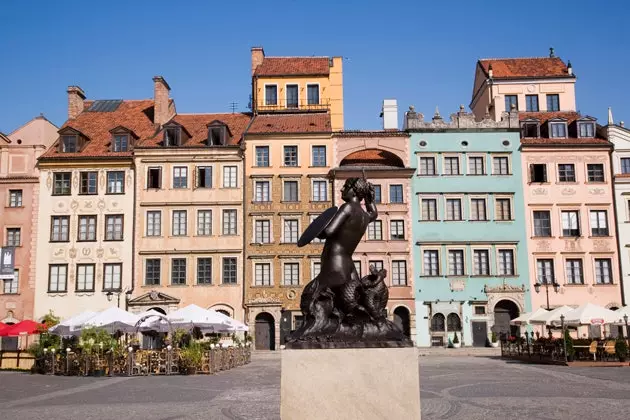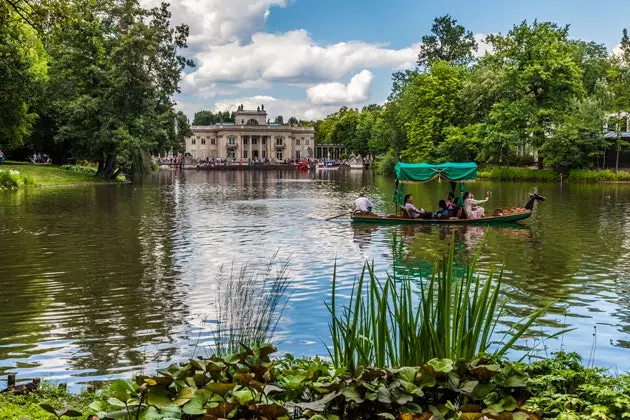
Warsaw, who said ugly?
1. FOR ITS ATTRACTIVE (AND TRAGIC) STORY
It seems that the song of 'The False Coin', “which goes from hand to hand” has been composed for Warsaw. His story is that of a love but they won't let me , or every time I try "someone puts a leg on me". Despite having its own entity since the Middle Ages, become the seat of the Throne and Parliament , and proclaim the first Constitution of Europe in 1791, since the end of the 18th century it passed into the hands of the Germans and the Russians. Thus until the beginning of the XX, 1918 in particular.
But then the joy did not last long. In 1938 it lost its independence again, and this time in a bloody way. During World War II, almost a million people died in the Polish capital. The Nazis turned the city into the largest ghetto in all of occupied Europe. Warsaw was razed to the ground, 85% of the buildings were destroyed. The Nazis left and the Communists came. Until 1989, the few Warsawians who remained after the war were subjugated by the Russians. Today it is a member country of the European Union that wounds are still healing.

Attractive for its history
two. FOR ITS MAGNIFICENT RECONSTRUCTION OF THE OLD TOWN
All the heritage of Warsaw is not such . What is false, come on. Said like this, it may seem like an insult, but nothing is further from the truth. The Old City was totally destroyed during World War II , but it was rebuilt so faithfully that UNESCO included it in the World Heritage List. Two squares of hectic and colorful life put the sauce to the Old Town of Warsaw. The Rynek Stare Miasto and the Rynek Nowe Miasto , the old and the new. They are reached after going through Nowy Swiat and Krakowskie Przedmiescie, the busiest and most commercial streets in all of Warsaw.
The two charming squares are bustling throughout the year but in summer they are the focus of attraction for street musical performances and open-air theater productions. If we go down one of its alleys, those that lead to the vistula river we will be able to hear how the music resounds while we point out charming bars and restaurants to go to when night falls. It is an area in which the festival merges with religious fervor. The oldest temples in Warsaw, such as the 14th century St. John's Cathedral, the Church of St. Martin or the Benevolent Mother of God are also located in the old part.

Rynek Stare Miasto Square
3. BY CHOPIN
The city where you live your first love will haunt you for life . This lapidary phrase could have been said by any intellectual, but no. It's mine. The most famous citizen of Warsaw is named Frédérik Chopin . In the Polish capital he lived his first love, but he also studied music, made friends, and gave his first concerts. The brilliant composer and pianist was born 50 kilometers from Warsaw, in Zelazowa Wola, in March 1810. That same autumn, the family moved to Warsaw. To follow the life and death of Chopin through the streets of the Polish capital, you have to visit the Holy Cross Church , where his heart rests; the modern Frédérik Chopin museum , inaugurated on the occasion of his 200th anniversary and which houses the world's largest collection of objects from the great musician; and the statue of Lazienki Park , next to which every Sunday from May to September recitals take place in his tribute at 12:00 and 16:00.

chopin statue
Four. FOR ITS GREEN AREAS
A quarter of Warsaw's area is green. Parks, squares, leafy banks on the banks of the Vistula or public-private gardens dot its urban landscape. It is true that many of these areas were built to delight the rich bourgeois in front of their luxurious palaces, but today they have become part of the city's public domain. The Garden of Saski, Lazienki or Wilanow are some of those that today have become historical.
But the city has continued to cultivate this taste for the freshness and serenity that green provides. An example may be the roof gardens of the University Library . They are worth visiting and exploring. From them you also have good views of the city on both sides of the Vistula and it is a charming place to fall in love. If this were not enough, Warsaw is one of the few cities in the world that can boast of integrating a National Park, the Kampinoski, which is also recognized by the World Biosphere Reserve.

Lazienki Park
5.**FOR PRAGUE (OR THE MOST HIPSTER WARSAW) **
Prague, on the right bank of the Vistula, years ago was an autonomous city that was incorporated into Warsaw in the 18th century. Today it is still independent territory . First, because the destruction of Warsaw did not affect him too much. Second, because it is where the more avant-garde artistic currents apart from more classicist movements Across the river. Today Prague is a fascinating neighborhood that artists have chosen for their workshops and galleries. The Soho Factory is based there, a complex of art galleries, designer and stylist boutiques, chic restaurants, markets and museums that have been responsible for resurrecting a depressed post-industrial area for years. In it we find the Neon Museum , a tribute to that graphic art turned into light that has so influenced our culture.
A visit to Magazyn Prague is also a must, a store with a concept and style that mixes the new with the old, the expensive and the cheap, the exclusive and the vulgar. Finally, you have to try something in the Warszawa Wchodinia , Chef Mateusz Gessler's restaurant where its exquisite New York design rivals excellent cuisine. Outside of Soho we still find many streets that fully preserved their buildings. Old lampposts and pavements from before the war come out to meet the traveller. Before leaving the neighborhood, it is a good idea to stop by the **Rózycki Market, the only one of its kind. **

The exquisite restaurant of Mateusz Gessler
6. FOR ITS CULTURAL VANGUARD
Warsaw has it all: young people with initiative, a deep culture and respect for their history. And what is more important, an enviable legacy of communist-era kitsch . There are already many venues scattered throughout the city, and those that are yet to open. As nightclubs have their specific niche in this article (see below), here we will focus on other types of initiatives. We have already talked about Prague and its Soho Factory.
In the neighborhood we also find the Czulosc Gallery which covers a very interesting avant-garde photography movement. They mix the photographic image with other types of media within contemporary culture with excellent results. In the area of the **Central Station we find the Café Kulturalna **, located on the ground floor of the Palace of Culture and Science . An elegant and eclectic space, during the day it hosts conferences, workshops and other academic activities. At night it becomes a concert hall for national and international groups and parties with world-famous DJs.
In the north of the city we have to visit the Zacheta National Art Gallery . For this reason, the works of Taduesz Kantor, Pawel Althamer or Wilhelm Sasnal have paraded. In addition, there are often meetings with artists, screenings of films that are difficult to project and concerts.

Pure artistic avant-garde in Warsaw
7. FOR KNOWING REMEMBERING HISTORY
Although throughout the city there are traces of its history, it is the Uprising Museum and in what little remains of the Warsaw Ghetto where the trace of pain and suffering but also of courage of the Polish people is evident. The Museum is located at Grzybowska, 79 . Through modern museumization, the struggle and daily life of the people who participated in the resistance against the Nazi regime but also against the communist invasion are shown, as well as the fate of many of them. Very little remains of the Ghetto, practically nothing, but I don't know why the suffering and destruction are still palpable in the area. What today is Muranow neighborhood, It was once the place created by the Nazis to isolate and kill the Jews. Traces remain on Marszalkowska Street: broken windows, dilapidated buildings... On Prozna Street, large photographs of victims of the Holocaust and the Great War hang on a building in clear decline.

A trip to the past and memory
8. FOR HIS PERSONAL PANORAMA
To understand Warsaw you have to go up to the Millennium Plaza . This building, also known as Reform, stands in Artur Zawisza Square. It has 31 floors and its terrace at 116 meters high has stunning views. Looking out we can more easily understand the past and present of Warsaw. In a tapestry the great avenues legacies of its totalitarian-communist past are drawn. And the quintessential symbol of that time, the ** Palace of Science and Culture emerges undaunted **. Russian work so that the Poles would not forget by whom they were governed, today it greets the traveler from any point of the city and is a rather kistch element totally integrated.
Next to the Palace, the irons twist forming the Warsaw Towers that symbolize the best and the worst of capitalism. Beyond, the Orc Tower , of modernist style shows us the power of this important real estate group. Black, and full of glass, the solid building of Warta shows the most robust and solemn face of the new Warsaw.

Skyline of Warsaw with the Palace of Science and Culture reigning
9. FOR ITS NIGHTLIFE
In Warsaw there are many good bars. **In all of them there is vodka, beer (piwo)** and a nice nightlife. Before going out, we can have dinner at the Bazar Klub, a perfect place to start the night. It has several environments, it is a place to eat but also to dance and have a few beers. From there we moved to the vicinity of the Narodowy stadium, the one that was built for the 2012 European Championship, where one of Warsaw's party zones . Pubs and the occasional nightclub greet the Vistula from the riverside.
Very close is the Powysle , train station by day and bar by night. Its pleasant terrace is ideal for enjoying a beer or a glass of cava, if necessary. Plan B, in Zbawiciela square , is the bar that everyone talks about in Warsaw. Especially students meet in a place that does not stand out precisely for its careful decoration, or yes. The fact is that the visit is a must and the atmosphere is very fun. To do clubbing we have to go back to Prague. There we find the Hydrozagadka where it seems that the night has no end. The cheapest option (and probably the most fun) is to go to the pajamas , in the center, in Nowy Swiat. It opens 24 hours and there are always people. At night it is the ideal place to meet young people. There are also caps.
10. FOR ITS RICH GASTRONOMY
Soup lovers: you are in luck. Every good Polish dish should be washed down with a good warm broth. There are a thousand ways: zurek (with fermented flour) ; barszcz czerwony (beetroot) ; krupnik (of barley) ; pomidorow zryzem lub makaronem (tomato with rice or with macaroni) ; etc. Second, the cooked dumplings (pierogi), the stuffed dumplings (pyzy) and the traditional steak tartare with minced meat and the delicious Warsaw-style herring (_sledz po warszawsk_u) triumph. To finish off a good sweet dessert based on Wuzetka cake or Blikle donuts . To take these delicatessen we should visit the Wedel chocolate shop, in the very center of Warsaw.
As for restaurants we have the Cu Miód It offers very good food at a fairly affordable price. It is a good place to go with friends or as a couple; the Klub Grawitacja , in the heart of the university district of Warsaw. Food rich in combined dishes at very affordable prices and with a very hipster decoration and atmosphere; and, finally, the Dwane Smaki , on Nowy Swia street, the Great Warsaw Way, we find traditional Polish cuisine in a select environment that includes a candlelit garden that will delight the most romantic . Refrain myopic.
*** You may also be interested in...**
- Poland's 'Milk Bars': Communist Relics of the Hipster Era - Poland's Prettiest Towns

Romance on the plate
